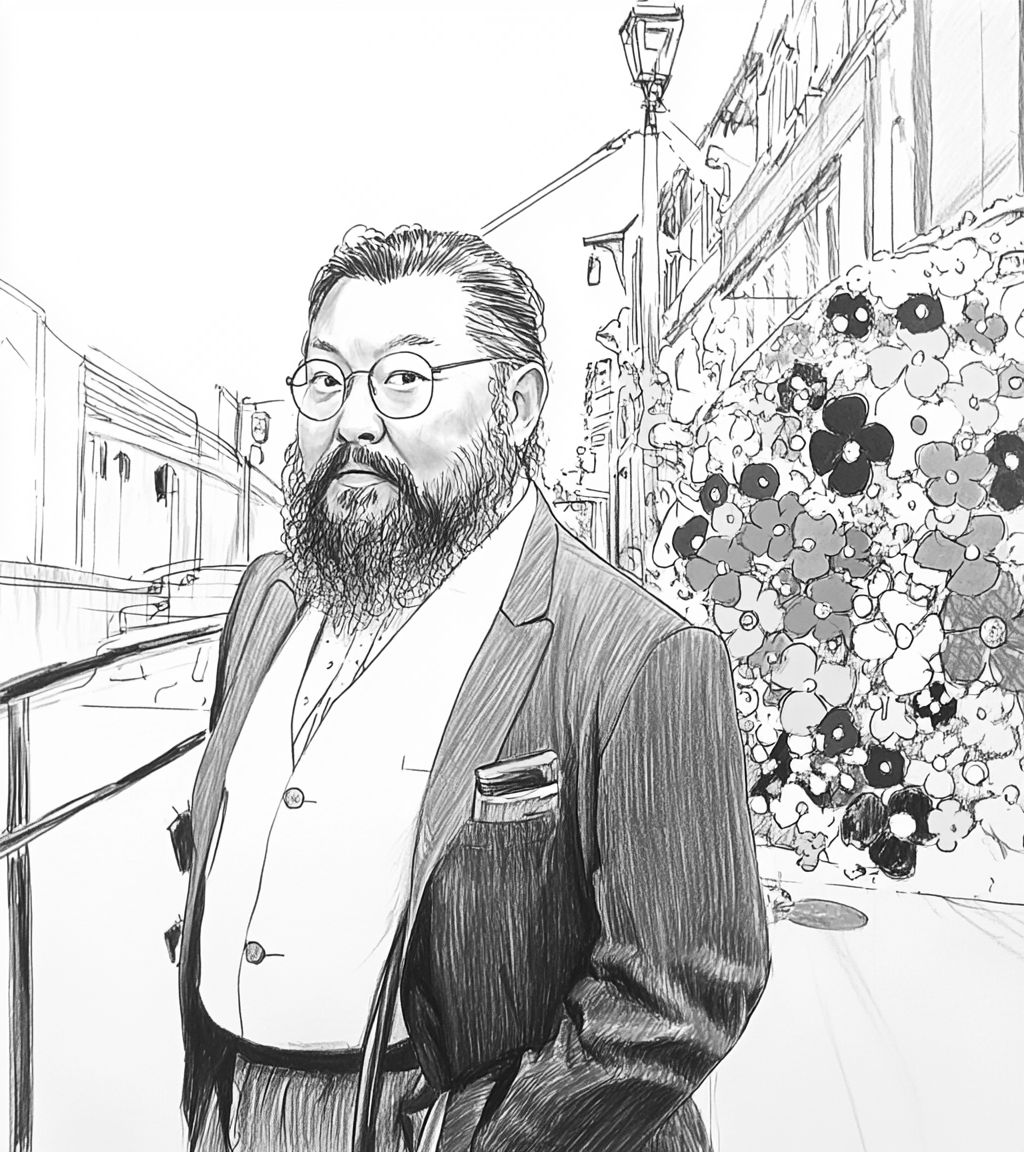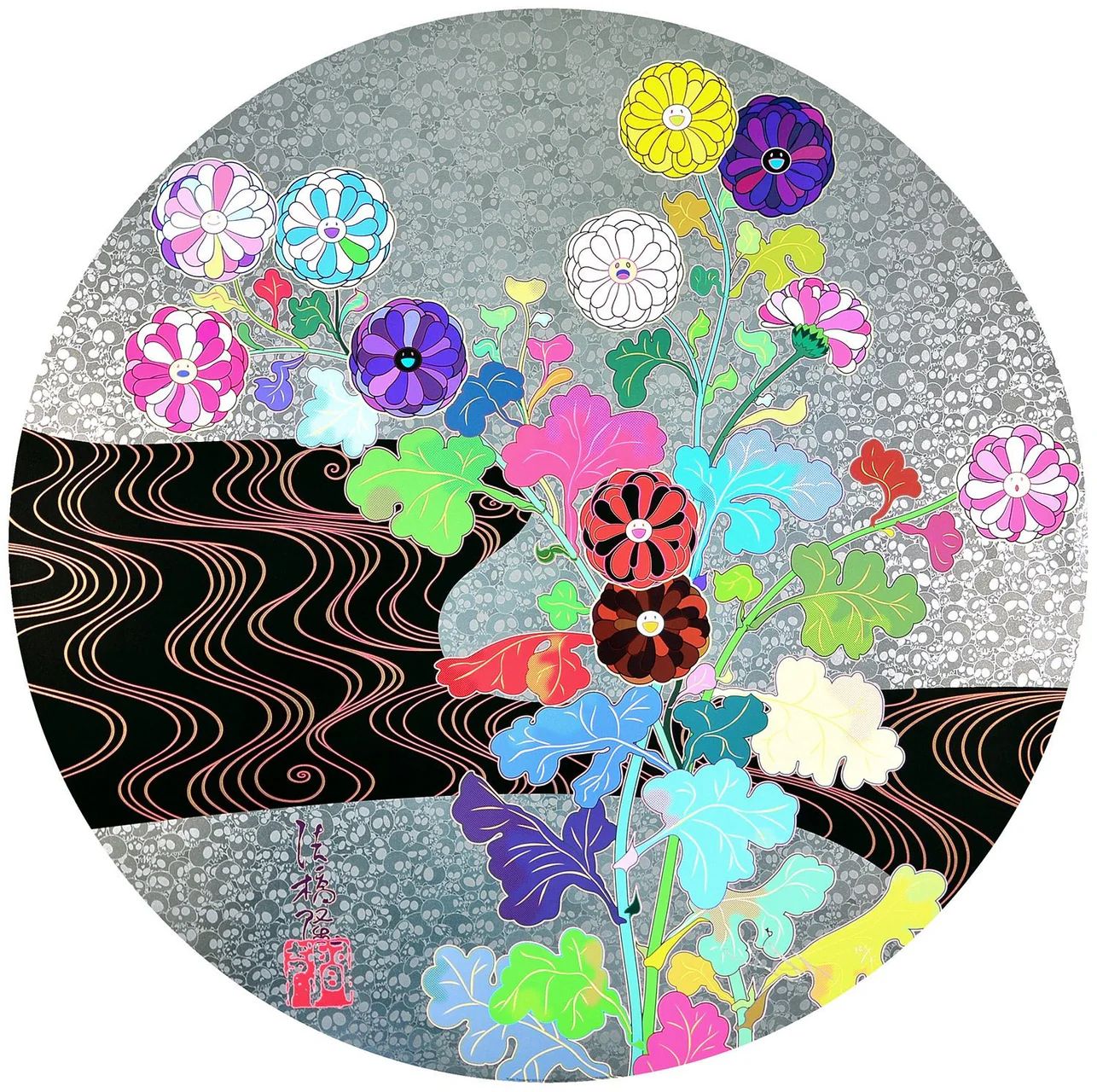
Takashi Murakami
Takashi Murakami studied traditional Nihonga painting at the Tokyo University of the Arts, earning a PhD in fine arts. Frustrated with the conservative nature of the Japanese art world, he began developing a new visual language that combined Japanese pop culture with contemporary art. In the late 1990s, Murakami gained international recognition through exhibitions in New York and Europe, positioning himself as one of the most prominent contemporary artists from Japan.
Murakami is best known for blending traditional Japanese aesthetics with modern pop culture in a style he calls “Superflat.” This concept flattens distinctions between high and low art, incorporating anime, manga, and commercial imagery into fine art contexts. His works often feature smiling flowers, cartoonish characters like Mr. DOB (his alter ego), and psychedelic color schemes. Influenced by both otaku culture and the legacy of Warhol’s Pop Art, Murakami critiques consumerism, globalization, and postwar Japanese identity while embracing their visual appeal.
Among Murakami’s most iconic works are 727 (1996), Tan Tan Bo series, and Flowers & Skulls. He has collaborated with brands like Louis Vuitton, bringing his art into global culture. Major exhibitions include Superflat (Los Angeles MOCA, 2001), Murakami (Brooklyn Museum, 2008), and The 500 Arhats (Mori Art Museum, Tokyo, 2015). His works are held in major collections, including MoMA (New York), Museum of Contemporary Art (Los Angeles), and the Broad. Murakami also founded Kaikai Kiki Co., a company that supports young artists and produces his merchandise and exhibitions.
Collected by major institutions and notable private collectors:
— Art Institute of Chicago— The Museum of Fine Arts
— Museum Brandhorst
— Fondation Louis Vuitton
Notable sales and auction records:
— My Lonesome Cowboy, USD 15,1 million at Sotheby's, New York, 2008— Miss ko², USD 6,8 million at Phillips, New York, 2010
— Red Demon and Blue Demon with 48 Arhats, USD 6 million at Phillips, New York, 2021
Artworks and Paintings
Biography and Artistic Career Highlights
Takashi Murakami was born on February 1, 1962, in Tokyo, Japan. He grew up in a modest family: his father worked as a taxi driver, and his mother was interested in sewing and calligraphy. From an early age, Takashi showed an interest in drawing and animation culture. His fascination with manga and Japanese cartoons (anime) became an important source of inspiration, shaping his future artistic path.
1980 — entered the Tokyo University of the Arts, where he studied traditional Japanese painting “Nihonga.”
1983–1993 — years of study and development: Murakami mastered the techniques of classical painting while also taking an interest in popular culture and contemporary art trends. In 1993, he received a doctorate in Fine Arts.
1994 — internship in New York on a grant, where he became acquainted with Western art and pop-art-inspired artists. This was a turning point in his career.
1990s — development of his own style, which he called “Superflat.” It combines the aesthetics of animation, advertising, and popular culture with traditional Japanese art forms.
1996 — established Hiropon Factory, a studio that later evolved into the international company Kaikai Kiki Co., which unites artists and organizes exhibitions.
2000 — published the “Superflat” manifesto, in which Murakami formulated the philosophy of his movement: erasing the boundaries between high art and popular culture.
2001 — founded the annual art festival GEISAI in Tokyo to support young artists.
2000s — collaborations with leading brands and designers, most notably with Louis Vuitton, for whom he created iconic collections of handbags and accessories featuring vibrant floral motifs.
2007 — major retrospective “Murakami” at the Museum of Contemporary Art in Los Angeles (MOCA), later shown in Brooklyn, Frankfurt, and Bilbao.
2010s — new projects and exhibitions worldwide, participation in art fairs and biennales, development of Kaikai Kiki, and continued support of young Japanese artists.
2018 — solo exhibition in Hong Kong reaffirmed his status as one of the most sought-after contemporary artists.
2020s — continues to work across various media: painting, sculpture, digital art, and NFT projects. His art increasingly addresses themes of globalization, catastrophe, and hope.
Today, Takashi Murakami lives and works in Tokyo, remaining a key figure in global contemporary art. His “Superflat” aesthetic has become a symbol of Japanese visual culture at the turn of the 20th and 21st centuries, and his works are part of major museum collections worldwide.

